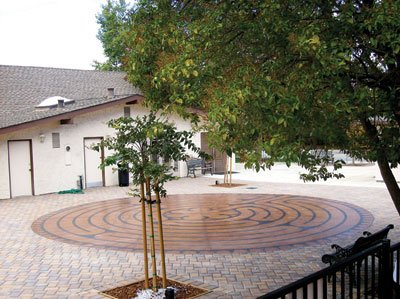An ancient means of fostering spirituality seems to be making a
surge of popularity during the 21st century. People around the
world are learning the benefits of
”
walking the labyrinth.
”
An ancient means of fostering spirituality seems to be making a surge of popularity during the 21st century. People around the world are learning the benefits of “walking the labyrinth.”
A labyrinth is a single-path maze with no tricks and no dead ends. People walk this “prayer path” slowly, as an aid to contemplative prayer, reflection, as a spiritual exercise or a form of pilgrimage. This month Morgan Hill’s Advent Lutheran Church (16870 Murphy Ave.) will be hosting a visiting labyrinth. South Valley residents are invited to visit and take part in this spiritual experience.
– Interactive Labyrinth: Oct. 11-21.
– Traditional Labyrinth: Oct. 22-27.
– Hours: Weekly, 9am to 10pm (Thursdays 9am to 12am).
– Phone (408) 779-3551 for group reservations or more information.
The 25-by-35-foot canvas labyrinth, which will be placed in the church’s lobby, is a contemporary version, with straight lines instead of curves. It also blends the ancient practice of labyrinth-walking with our popular culture, including, televisions, computers and other physical objects from everyday life. The effort is to show how God “meets us in the stuff of everyday life, in the real world.”
The pathway was created and brought to Morgan Hill by Roger Coutre, Youth Minister at the First Presbyterian Church in Hollister and a retreat-leader at St. Francis Retreat Center in San Juan Bautista, where his creation gained great popularity before the original was destroyed in a fire.
There are 11 stations for participants to pass through; the total journey should last about an hour.
1. Inward Journey: Listening to music on a personal CD player, a theological backdrop for the journey ahead;
2. Noise: Quieting down to achieve a thoughtful, prayerful frame of mind;
3. Letting Go: Stones represent cares and concerns;
4. Hurts: A ritual to confess injuries done to others and receive forgiveness;
5. Distractions: An interactive exhibit expressing how focus is taken away from God;
6. Holy Space: Center of the labyrinth, a place to be seated and receive God;
7. Outward Journey: A preparation to go back into the world;
8. Self: A place to explore one’s relationship with self;
9. Planet: An opportunity to participate in God’s creation;
10. Others: An opportunity to think about relationships and pray for others;
11. Impression: A chance to reflect on one’s effect on the world.
In the Middle Ages, many European cathedrals contained prayer paths etched into the floor. They were considered a symbol of the Christian Way, representing the path of the soul through life. Medieval pilgrims participated in this ritual, often following the path of the labyrinth on their knees as a means of prayer or to symbolize a pilgrimage to the Holy Land. But with the Renaissance, the spiritual uses of labyrinths were mostly forgotten, and they fell into disuse.
In recent years, labyrinths have been rediscovered as spiritual tools and have become increasingly popular. Most have been based on a pattern of circles and spirals found in the floor of Chartres Cathedral in France. The visiting labyrinth at Advent, however, is based on one devised for use at London’s St. Paul’s Cathedral for the Millennial Celebration in 2000.
The visit of this labyrinth is a unique opportunity to participate in a meaningful journey into greater consciousness of God. For those who are unable to attend, more than 160 churches in California provide prayer paths. Visit www.Veriditas.org for locations.
Morgan Hill’s St. John the Divine Episcopal Church (17740 Peak Ave.) recently installed a permanent Chartres-style labyrinth in its courtyard and is forming a guild of volunteers to facilitate its use by the public. For more information, call (408) 779-9510.
Finally, miniature labyrinths for personal devotions can be ordered on at www.relax4life.com.












